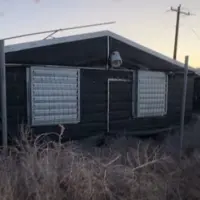
Oklahoma City, OK – Beckham County Sheriff Derek Manning says a statewide surge in abandoned marijuana grow sites is leaving rural neighbors with trash, chemical waste, and rising calls for help. His office has fielded complaints about wind-shredded plastic from hoop houses, scattered fertilizer and soil sacks, and concerns about leftover chemicals blowing into pastures and creeks.
Manning shared those observations with state officials ahead of an interim legislative study focused on what to do with deserted facilities and who should pay for cleanup.
“I had talked to a senator a while back and given her a little information,” Manning said. “I just told [OBN] the things that we had seen out here, which are the trash that is blowing around, the plastic… and there are concerns about the chemicals that are left behind.” He added that vandalism and theft also follow once sites are deserted. “People are scavenging, stripping copper, stealing whatever metal they can find.”
The sheriff said tracking down responsible owners is often impossible because many grows used “straw ownership” arrangements [someone with Oklahoma residency listed on paper while others actually operated the site]. “I’m hoping they can identify who the property owners are or, in the short term, start some kind of resale so this property goes back to legitimate use,” Manning said. He suggested a cleanup fund or discounted resales that require buyers to remediate the sites.
At the Capitol last week, the House Alcohol, Tobacco, and Controlled Substances Committee heard from the Department of Environmental Quality [DEQ], the Oklahoma Bureau of Narcotics [OBN], the Oklahoma Medical Marijuana Authority, and the Oklahoma Water Resources Board. The agencies showed photos of mounds of garbage, chemicals, and biohazards left behind.
“Some of these marijuana facilities are packing up and leaving in the middle of the night and leaving all of their mess behind to be cleaned up,” state Rep. Cynthia Roe said.
OBN Deputy Director Brian Surber said the worst conditions are in rural areas. “The rural grows in rural Oklahoma, that is where we see just a huge, the filth, the unsanitary,” he said. Surber added that jurisdiction is murky. “I’m not sure it’s really clear who has the jurisdiction on that, and I think that may be what the problem is.”
DEQ officials said they have received 440 complaints involving marijuana grow facilities. However, unless a site is licensed by the state, the agency does not investigate. “If they are unlicensed by OMMA, then we don’t inspect it for safety purposes because we actually have safety concerns going out to licensed facilities,” said Madison Miller, DEQ’s deputy executive director. She noted DEQ’s current role does not include restoring land after a grow shuts down. “If we were to go in and clean it up, we would need funding to do that.”
OBN estimates there are just under 2,000 licensed grows operating in Oklahoma today, down from about 8,000 in 2022. Officials attributed the decline to administrative crackdowns and law enforcement actions, including warnings about straw ownership that prompted many operators to exit.
Manning said the problem should have been anticipated when legalization began. “We’re here now and we’ve got to figure out a way to address it,” he said. Any fix, he added, must respect property rights while giving counties a workable path to clean up dangerous sites.
Lawmakers signaled they will explore funding mechanisms, clearer jurisdiction, and potential resale or remediation requirements. No timetable for proposed legislation was announced.
Copyright 2025 Paragon Communications. All rights reserved. This material may not be published, broadcast, rewritten, or redistributed without permission.









